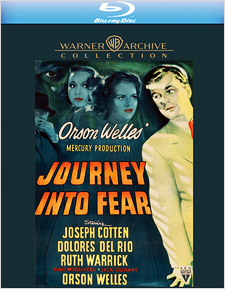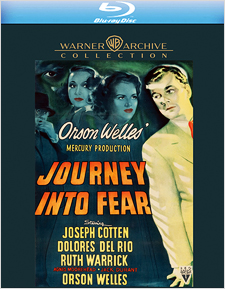Journey Into Fear (Blu-ray Review)

Director
Norman FosterRelease Date(s)
1943 (October 1, 2024)Studio(s)
Mercury Production/RKO Pictures (Warner Archive Collection)- Film/Program Grade: C+
- Video Grade: A
- Audio Grade: A
- Extras Grade: B-
Review
Like David O Selznick with Gone with the Wind, Orson Welles directed his masterpiece—Citizen Kane—when he was fairly young. Both men’s subsequent work was judged against those two films and usually suffered by comparison. Unlike Selznick, Welles would step out from behind the camera occasionally to take on a role, as in Citizen Kane. In Journey Into Fear, a noir melodrama of international intrigue, he played a small but significant role with impressive panache.
As Colonel Haki, Welles has two big scenes that bookend the film but are otherwise not seen. He makes an imposing entrance as a looming, mysterious figure who soon reveals himself to be the head of Turkish intelligence whose orders must unquestionably be obeyed. In the climactic scenes, he resurfaces amid deadly danger.
Joseph Cotten (Hush...Hush, Sweet Charlotte) plays the lead role of Howard Graham, an American munitions expert traveling for a combination of business and sightseeing with his wife (Ruth Warrick, Forever and a Day). When they make an overnight stop in Istanbul, he’s met at his hotel by his company’s foreign representative Kopeikin (Everett Sloan, The Lady from Shanghai). Graham wants to dispense with Kopeikin’s errand quickly and be alone with his wife, but the representative insists they go out on the town to talk business and Graham reluctantly agrees. During a nightclub performance, a magician (Hans Conried, Nightmare) is murdered. The authorities arrive and that’s when a large man in bulky furs, face obscured under a tall fur hat, strides into a private room to interview witnesses. That commanding presence is Colonel Haki.
The colonel orders Graham into the room and convinces him that he was the intended target. The Nazis have sent an assassin by the name of Banat (Jack Moss) to kill him. Attired in a trenchcoat and wide-brimmed fedora, the bespectacled Banat is a creepy figure—obese and unsmiling. To safeguard Graham, Haki will have him smuggled on a cargo ship out of the country, where he will rejoin his wife. Should Graham believe Haki or not? No matter. Haki dispatches enforcers to make sure Graham gets on that ship.
The scenes on the ship are claustrophobic and ominous. The passenger cabins are small, visibility is obscured, and even the deck disappears into the mist. On board, Graham encounters an oddly friendly tobacco dealer named Kuveti (Edgar Barrier, Tarzan and the Leopard Woman). Also on the ship are professional dance partners Josette (Dolores Del Rio, Madame Du Barry) and Gogo (Jack Durant, Four Jacks and a Jill), on their way to their next booking. Josette displays unusually sympathetic interest in Graham and warns him against playing poker with her cardsharp partner. Are any of these people trustworthy?
The passengers disembark during a raging rainstorm and Graham is ushered to the hotel where he expects his wife to be waiting. A terrific chase ensues with characters shooting at each other on the ledge of an upper floor in the driving downpour that’s beautifully shot by Karl Struss. That climactic sequence is, in style, far removed from the unimaginative look of the ship scenes, shot from the least interesting angles. Only one moment in the ship sequence—a low-angle shot of Graham descending a staircase to the dock—stands out for its thoughtful composition. Aside from the climax and that one low-angle shot, the rest of the picture has a dull studio-bound appearance.
Cotten is credited with writing the screenplay and Norman Foster is the credited director. When Welles is on screen, he dominates with his deep baritone, tall stature, and commanding presence. Because he’s absent for most of the picture, it never fully comes alive. Director Foster attempts to generate suspense by assembling a number of suspicious characters, yet there’s never a real sense of tension.
Cotten’s performance lacks spark, and he looks like he’s coasting until the finale. Del Rio is on hand as a possible red herring or femme fatale but is underused. She and Welles were having an affair at the time, which may have accounted for her casting. In addition to Cotten, Sloan and Warrick, Agnes Moorehead (Magnificent Obsession) plays Ms. Mathews, a talkative passenger on the ship. Apparently, Welles wished to use as many actors from his Mercury Theatre of the Air radio actors as possible.
The film, based on a novel by Eric Ambler, is hard to follow. An off-screen narrator was a post-production idea to make sense of the narrative, but due partly to some characters’ dual identities and partly to lack of clarity, the film is still confusing. It’s one thing to strain credibility, but the plot of Journey Into Fear is so convoluted, it’s preposterous. Norman Foster provides ho-hum direction and fails to fully exploit opportunities for building suspense. The subject matter and some of the scenes reminded me of The Third Man because of the European setting and the presence of Orson Welles, but Journey Into Fear lacks the stylish touches that director Carol Reed so effectively incorporated into The Third Man.
Journey Into Fear was shot by director of photography Karl Struss on 35 mm black & white film with spherical lenses, finished photochemically, and presented in the Academy aspect ratio of 1.37:1. The Blu-ray from Warner Archive is sourced from a 4K scan of safety preservation master positives on loan from the Library of Congress. Clarity is very good and details are well delineated in Dolores Del Rio’s glittery nightclub costume, the ship’s cabins, decor in the hotel lobby, Haki’s crisp, tailored uniform, and rain pouring onto a building ledge as a chase ensues. Blacks are deep and velvety and the greyscale is nicely rendered. Deep shadows are used, especially when the creepy Banat is shown lurking, observing, waiting. Lighting in Graham’s hotel lobby is bright, and the nightclub’s stage is illuminated while the audience is in shadow. The visual highlight of the film is the climactic scene on a treacherous ledge in a heavy downpour. As chases go, it’s certainly inventive, since it involves stealth, precision, and sure-footedness rather than breakneck speed. As in most studio films of this era, rear screen projection is used to suggest that a studio car is in motion on the open road.
The soundtrack is English 2.0 DTS-HD Master Audio Mono. Optional subtitles are included in English SDH. Dialogue is clear and distinct. Welles’ booming baritone makes clear why he had such success on the radio. Sloan’s speech is intentionally quick and annoyingly insistent as he becomes Graham’s guide to Istanbul. There’s a bit of singing in the nightclub as part of background ambient sound. The score, by resident studio composer Roy Webb, falls short in helping the narrative achieve peak suspense. The music is at its best during the final scene when all stops are pulled, contributing to an exciting, nail-biting sequence.
Bonus materials on the Blu-ray release from the Warner Archive Collection includes three Mercury Theatre radio broadcasts:
Dracula (59:29) – Based on the novel by Bram Stoker, this program was broadcast on July 11, 1938 and starred Orson Welles in the dual roles of Count Dracula and Dr. Seward, Elizabeth Farrell as Lucy Westenra, George Coulouris as Jonathan Harker, Agnes Moorehead as Mina Harker, and Martin Gabel as Dr. Van Helsing.
Treasure Island (64:05) – Adapted from the novel by Robert Louis Stevenson, this program aired on July 18, 1938. Its cast included Orson Welles in the dual roles of Long John Silver and adult Jim Hawkins, Arthur Anderson as Jim Hawkins, George Coulouris as Captain Smollett, Ray Collins as Ben Gunn, Agnes Moorehead as Mrs. Hawkins, and Eustace Wyatt as Squire Trelawney.
A Tale of Two Cities (59:26) – Based on Charles Dickens’ novel set during the French Revolution, this program was broadcast on July 25, 1938. Its stars were Orson Welles in the dual roles of Sydney Carton and Alexandre Manette, Mary Taylor as Lucie Manette, Edgar Barrier as Charles Darnay, Martin Gabel as Jarvis Lorry, and Betty Garde as Madame Defarge.
Journey Into Fear is interesting in that it was an early example of film noir from the studio—RKO—that would see its coffers filled in years to come from its steady stream of low-budget noirs. Orson Welles is alleged to have had more of a hand in creating this film than the credits reveal, but he apparently lost interest in the project and turned it over to Foster, who completed it and received sole directorial credit. Cotten has sole screenwriter credit, but his IMDB filmography lists only Journey Into Fear and uncredited additional scenes from The Magnificent Ambersons as his writing credits, so it’s quite possible that Welles was involved in the script as well. The film is only 68 minutes long, so a few scenes to sharpen the narrative and provide greater depth to characters would hardly have over-padded the picture.
- Dennis Seuling

